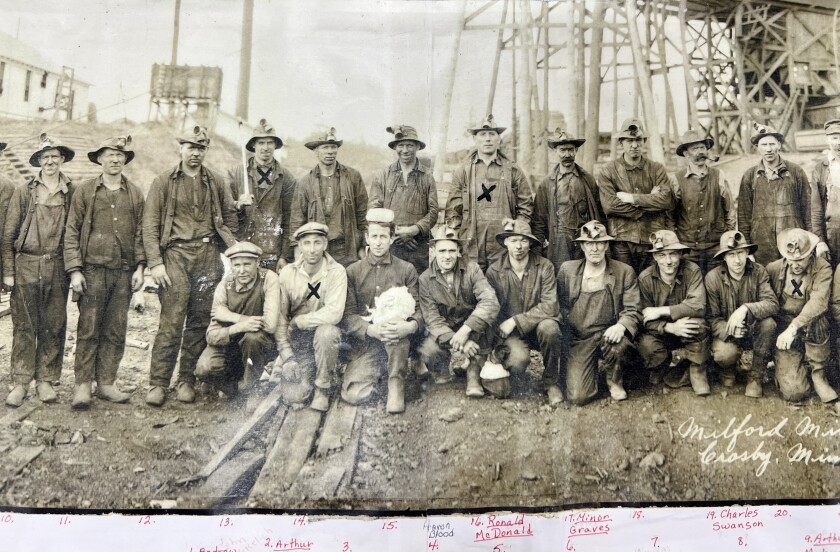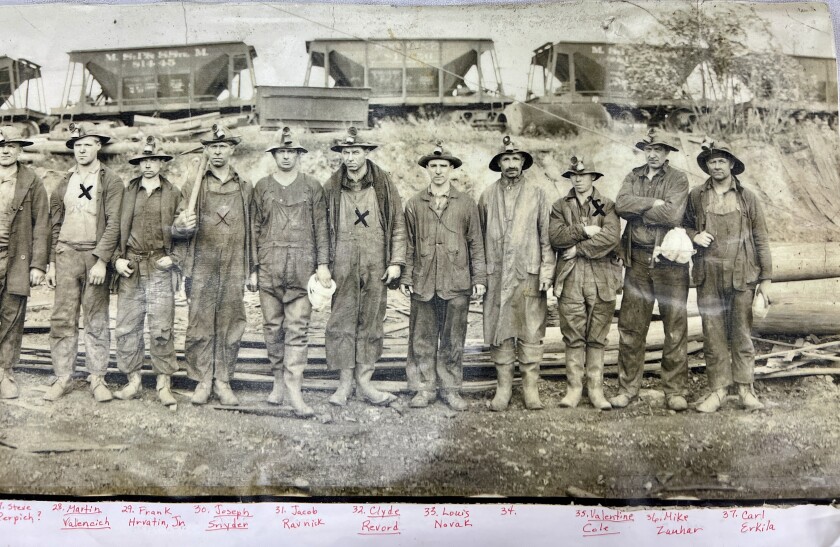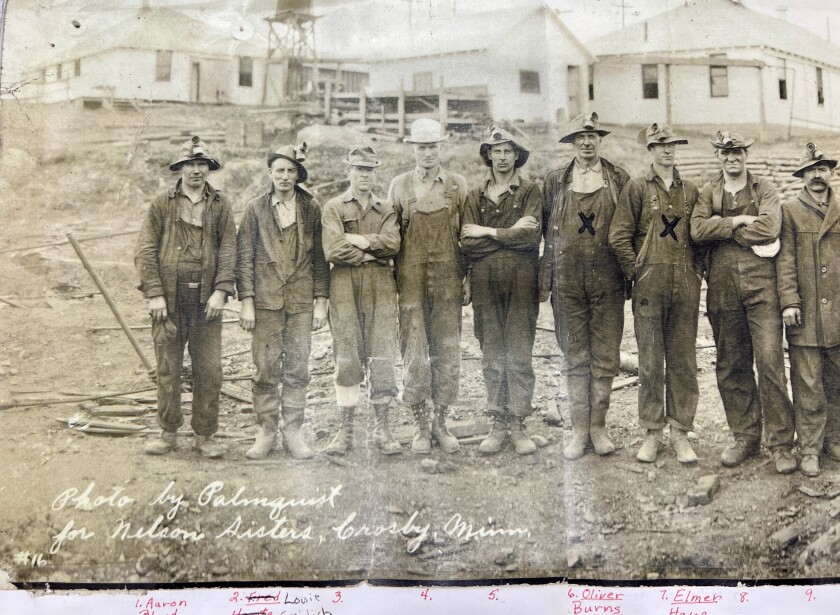CROSBY — Clinton Harris must have known he was doomed.
Seven survivors passed him on their way to the lifesaving ladder out of the Milford Mine. Behind them, Foley Lake was rushing with water and mud .
ADVERTISEMENT
Harris, the skip tender, was posted near the shaft controlling the skip that took miners up and down as well as the ore being removed from the mine. Harris wasn’t supposed to be working that day shift but was filling in for another miner.
When a second blast of air hit him and the electric lights went out in the mine, Harris pulled the rope to sound the warning whistle, alerting those below and above ground of danger. The miners who ran past him urged him to join them.
But Harris was concerned that men in the far reaches of the mine hadn’t heard the whistle. They likely couldn’t have imagined the speed of the disaster racing toward them.
Harris must have known he wasn’t going to make it out when he tied the rope of the whistle around his waist and the water rose swiftly on its way to fill the entire mine within minutes.

The Milford whistle inspired other mines and locomotives to sound their own whistles in response. People quickly gathered at the Milford mine shaft but there was nothing they could do as the black water rose nearly to the top of the shaft.
The exhausted survivors sprawled on the ground outside.
The Milford whistle continued to blow for four hours until someone cut the rope above ground. Months later, when Harris’ body was recovered, the rope was still tied around his waist.
ADVERTISEMENT
Nine months after the mine flooded, the last body was found and removed from the mine. Over 4 million cubic feet of water was drained from the Milford Mine and Foley Lake with mud brought up by buckets.

The loss of the 41 miners, many young men with wives and children, that day in 1924 remains the state’s greatest mining tragedy and one of the worst in the nation.
Monday, Feb. 5, on the 100th anniversary of the Milford Mine disaster, people filled the Crosby-Ironton High �������� auditorium to hear the stories of the miners who lost their lives that day. Songs written about the tragedy were played and each miner’s name read.
Stories of their lives, with many of them immigrants from Finland, Austria and Eastern Europe seeking a better life, were retold. Exhibits with photos, artifacts and a diagram of the mine were on display in the cafeteria where people gathered after the presentation by the Cuyuna Iron Range Heritage Network.

Mike Aulie, whose father Berger Aulie wrote the book the “Milford Mine Disaster: A Cuyuna Range Tragedy” and a volunteer with the Heritage Network, began the night by blowing a whistle and thanking people for coming.
“This turnout is fantastic and to see so many people interested in this part of our history and legacy in this area, it’s great to see,” Aulie said.
After the event, as people made their way to the cafeteria to continue to look through documents and talk with each other and Heritage Network representatives, Aulie said the turnout was what they hoped for but they weren’t sure how many would attend. He was told someone drove from Colorado to the event because they had a relative who died in the mine.
ADVERTISEMENT
Aulie said estimates are about 400 people attended, more than they ever expected. They printed 200 programs and ran out before the program started. The presentation brought together those who were continuing to learn details about the event and relatives of those who perished in the mine.

“I thought it was great,” said Jeanine Nephew, Cuyuna, of the presentation. Nephew, who attended with her family and her daughters and had family members who perished in the mine, said she was impressed with the turnout. More than one person was affected by the disaster from both sides of their families.
“It was just beautiful, very emotional,” said Valene Perpich of Ironton. “It honored everybody that was involved, even, you know, the widows, the children.”
Perpich and Mary Ellen Wasson, whose grandfather, Peter Magdich, died in the mine, both praised the program. Perpich said her grandfather’s body was recovered from the mine about three weeks after her mom was born. One of the songs presented at the event was about her grandparents, including photos from their wedding.
It was a story they’ve kept alive in the family, but Perpich said she is glad it is finally being recognized by the general public. A presentation on the Milford Mine was hosted earlier Monday for Crosby-Ironton eighth graders. Perpich said for a long time, it seemed the Milford Mine was forgotten and lost to history. Wasson said she talked to a lot of people at the event who were learning things they didn’t know about the area.
Speakers at the presentation included Cuyuna Range Elementary �������� student Abby Kayfes, Julie Bordwell Maus and Joan Stefano.

Stefano’s father worked in the Milford Mine. He was moved to another location in the mine as they put a railroad track overhead. That was in December of 1923. The new location left Stefano’s father feeling sick from fumes and the smoke. After a few days he went back to the captain and said he couldn’t eat or sleep and if he stayed in the Milford he would die.
ADVERTISEMENT
“Little did he know that was prophetic,” Stefano said.
The captain asked for two more weeks. In the first week of January of 1924, her father quit.
“It was the sense of smell that saved his life.”
Bordwell Maus said she feels the tragedy could have been avoided. Her grandfather, an Italian immigrant, worked in the Milford Mine. Bordwell Maus said his job was a timberman in the mine who would secure the area for miners. Bordwell Maus said two weeks before the tragedy her grandfather saw seepage in the mine and went to the surface to immediately inform the foreman.
Bordwell Maus said her grandfather told her he didn’t think they listened to him because he was just a young immigrant.

“My grandfather quit that very day,” she said, noting he had a wife and six children to support. He continued to work in the mining industry into the 1950s. Bordwell Maus’ mother was born years after the Milford Mine disaster.
Crow Wing County commissioners Steve Barrows, Jon Lubke and Doug Houge attended the event. The County Board has made a priority of preserving the Milford Mine with a memorial park and continues to invest in the park. A presentation for the anniversary year and to unveil new additions to the park is expected in early summer.
ADVERTISEMENT
Houge represents the Cuyuna Range.
“They did an excellent job,” Houge said of the presentation. He said people were emotional during the event and he said he learned things about the Milford Mine he never knew before. “It’s really neat that it’s not forgotten … I think it just shows the heritage of this area.”
Renee Richardson, managing editor, may be reached at 218-855-5852 or renee.richardson@brainerddispatch.com. Follow on Twitter at www.twitter.com/DispatchBizBuzz.









